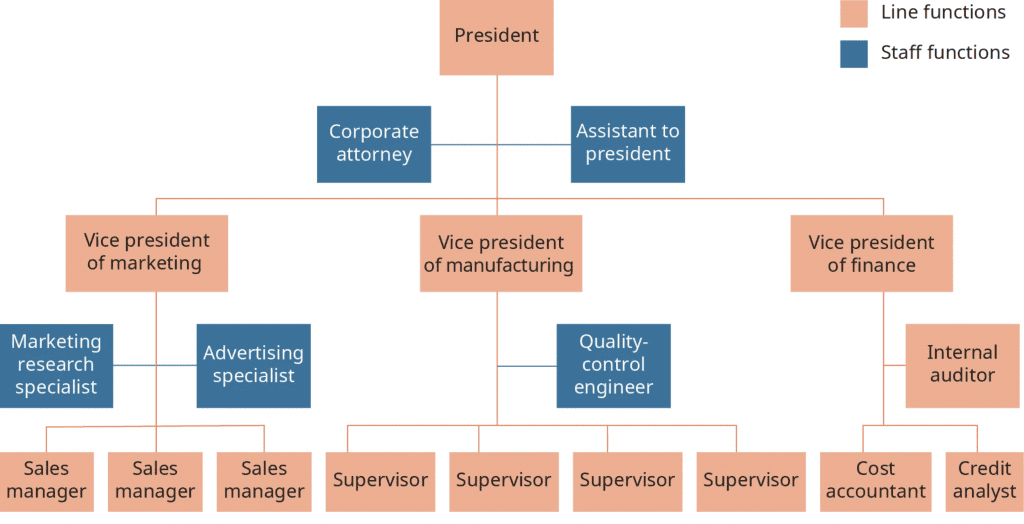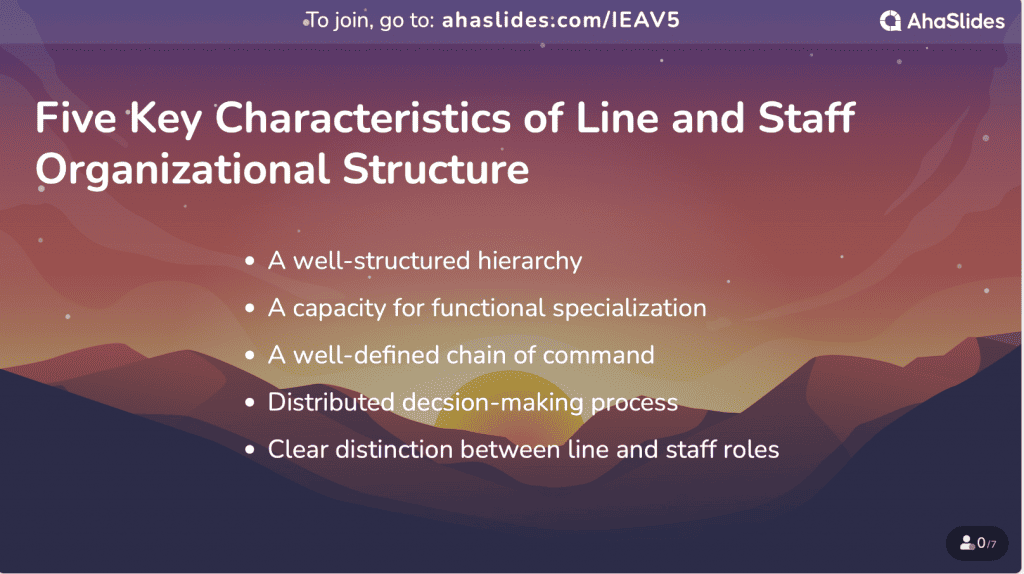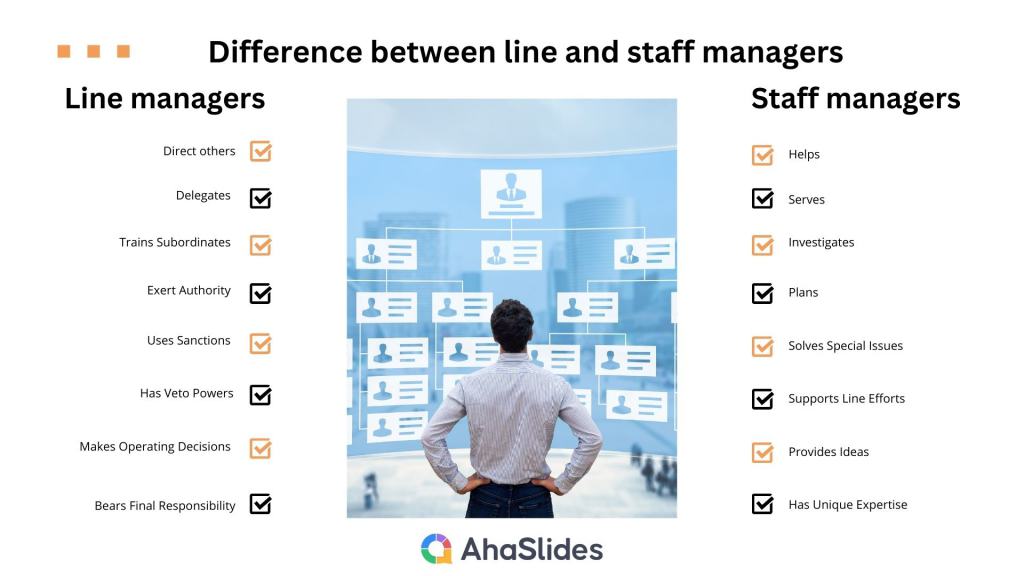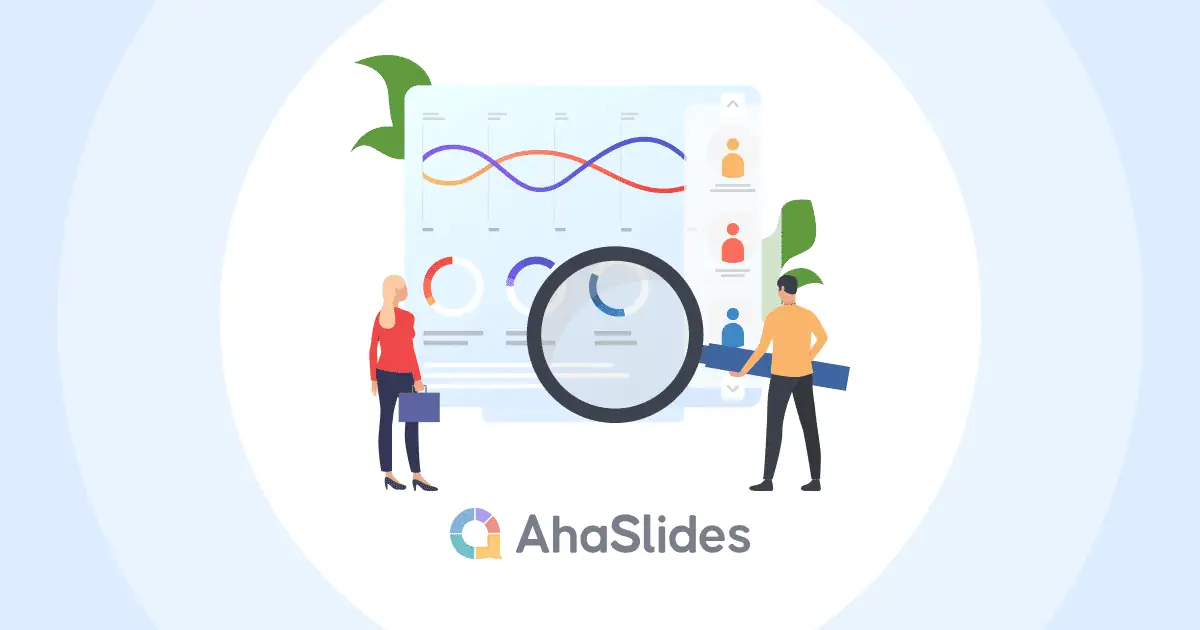In the business sector, organizational structure plays a key role in shaping an organization's success. In this article, let's explore line and staff organizational structure more profoundly, from its definition, core components, values, and limitations, to real-life cases illustrating examples.
These are all practical insights for those contemplating adopting this approach because, in today's ever-evolving business landscape, mastering organizational structures and staffing lines is critical to optimizing operations and making informed decisions.
| Is line and staff organization the oldest form of organizational structure? | Yes |
| What are examples of companies that use line and staff organizational structures? | General Electric, and Procter & Gamble. |
Table of Contents
- What is Line and Staff Organizational Structure?
- Five Key Characteristics of Line and Staff Organizational Structure
- Benefits of Line and Staff Organizational Structure
- Drawbacks of Line and Staff Organizational Structure
- Line and Staff Organizational Structure Examples
- Key Takeaways
- Frequently Asked Questions
What is Line and Staff Organizational Structure?
In the complicated world of organizational design, the line and staff organizational structure is a fundamental concept. This frame defines the organisational model through which an institution's tasks, responsibilities, and communication channels are organised and delegated. At its core, the line and staff organizational structure distinguishes between two primary elements of roles within an organization: line structure and staff structure.
- Line Structure: They are directly involved in the day-to-day operations and activities related to an organization's core functions. These positions form the backbone of the organization and are typically involved in producing goods or delivering services. Line positions are crucial for the organization's primary goals and are often the ones making operational decisions.
- Staff Structure: They provide support, advice, and expertise to the line positions. They are not directly involved in the production process but play a critical role in facilitating and enhancing the efficiency of line functions. Staff positions often include specialists in areas such as human resources, finance, legal, and technology.

Five Key Characteristics of Line and Staff Organizational Structure
How does Line and Staff Organizational Structure work? These are the five primary characteristics that should be noted:

- Hierarchical Order: The line and staff organizational structure is defined by a well-structured hierarchy. Line positions hold the primary responsibility for core functions, and they are positioned higher in the organizational hierarchy compared to staff positions. This hierarchy ensures a clear reporting structure and delineates authority levels within the organization.
- Functional Specialization: One of the strengths of this structure lies in its capacity for functional specialization. Staff members in roles such as human resources, finance, or legal bring specialized knowledge and expertise to support and enhance the efficiency of line functions. This specialization allows organizations to tap into specialized skills while maintaining a strong operational core.
- Chain of Command: The chain of command is well-defined. Line positions typically report to other line positions or superiors within their functional area. This clarity in reporting relationships ensures that decision-making authority and responsibility are distributed logically throughout the organization.
- Decision-Making: Decision-making within a line and staff structure is typically distributed between line and staff positions. Line positions have greater authority and autonomy when it comes to day-to-day operational decisions. In contrast, staff positions provide valuable expertise and recommendations, influencing decisions that impact the organization's strategic direction and efficiency.
- Clarity of Roles: One of the primary advantages of this structure is the clear distinction between line and staff roles. Line positions are responsible for executing core functions, while staff positions focus on supporting and optimizing these functions. This separation of roles enhances clarity in responsibilities, reducing potential conflicts and overlaps within the organization.
These key characteristics form the foundation of the line and staff organizational structure. Understanding these fundamental aspects is essential as we explore the structure's intricacies in the subsequent sections, where we will delve into its advantages and disadvantages in greater detail.
Benefits of Line and Staff Organizational Structure
The line and staff organizational structure offers a multitude of advantages that render it an appealing choice for a wide array of organizations. These advantages contribute to its sustained popularity and effectiveness. Let's delve into the key benefits of this organizational model:
- Distinct Roles and Responsibilities: Within the line and staff structure, roles and responsibilities are meticulously delineated. Line positions bear the responsibility for essential operational functions, ensuring a dedicated focus on day-to-day tasks. Conversely, staff positions provide specialized support and expertise, augmenting the overall efficiency of the organization.
- Specialization: With staff positions dedicated to specific functions like HR, finance, or legal, organizations can tap into specialized knowledge and skills. This specialization results in improved performance and expertise in critical areas, contributing to the organization's overall effectiveness.
- Streamlined Decision-Making: Line positions typically have the authority to make operational decisions independently. This streamlined decision-making process allows organizations to respond swiftly to routine challenges and opportunities. Staff positions complement this by offering guidance and expert insights, ensuring that decisions align with strategic objectives.
- Efficient Resource Allocation: The line and staff structure enables organizations to allocate resources optimally. Line positions focus on resource utilization to meet operational goals, while staff positions help manage resources strategically, ensuring they align with the organization's broader objectives. This approach leads to efficient resource utilization.
- Adaptability and Flexibility: The presence of staff positions enhances an organization's adaptability. Staff experts provide guidance when faced with new challenges or opportunities, allowing the organization to remain agile and responsive to changing circumstances.
- Informed Decision Support: Staff positions play a crucial role in providing informed decision support. Their specialized knowledge and expertise are invaluable when making strategic decisions, especially in industries with complex regulations or evolving technologies.
These advantages collectively make the line and staff organizational structure an appealing choice for organizations seeking to strike a balance between operational efficiency, specialization, and adaptability.

Drawbacks of Line and Staff Organizational Structure
Although the line and staff organizational structure has many advantages, it is not perfect as well. We need to recognize these challenges to make informed decisions and minimize possible crises. Let's see what the main disadvantages of this organizational framework are:
- Communication Challenges: The division of roles between line and staff positions can create barriers to effective communication, potentially resulting in information silos and hindering decision-making processes.
- Conflict Potential: The distinct roles and responsibilities inherent to the line and staff structure may lead to conflicts within the organization. These conflicts can disrupt collaboration, morale, and overall productivity.
- Resistance to Change: Organizations transitioning to a line and staff structure may encounter resistance from employees accustomed to different organizational models. Successfully managing this resistance and ensuring a smooth transition can be a significant challenge.
- Increased Overhead Costs: Maintaining specialized staff positions requires additional investment in recruitment and retention, potentially raising overhead costs. This can pose financial challenges, particularly for smaller organizations or those with limited resources.
Line and Staff Organizational Structure Examples
To gain a deeper understanding of the practical applications and achievements of the line and staff organizational structure, it is crucial to learn from real-world instances of organizations that have successfully adopted this framework:
General Electric (GE)
General Electric, renowned as one of the world's largest and most diversified industrial conglomerates, has a longstanding history of embracing the line and staff organizational structure. Within GE, line roles across diverse business units take charge of fundamental operations, including manufacturing and services. Concurrently, corporate-level staff positions offer specialized expertise in areas such as finance, human resources, and legal.
⇒ This organizational approach has empowered GE to streamline its operations and harness specialized skills, playing a pivotal role in its success across multiple industries.
Procter & Gamble (P&G)
Procter & Gamble, a globally recognized consumer goods giant, serves as another illustrative example of an organization effectively utilizing the line and staff structure. At P&G, line roles operating within product divisions assume responsibility for core functions such as product development and marketing. In parallel, corporate-level staff roles extend support to these divisions by providing expertise in domains like supply chain management, finance, and research and development.
⇒ This organizational paradigm has enabled P&G to optimize its product innovation and distribution processes, contributing to its competitive edge."
Key Takeaways
You've learned about line and staff organizational structure, and it sure helps you get a better understanding of your company's current management structure.
💡 If you also are looking for innovative solutions to increase employee satisfaction and engagement in any kind of company activities, from survey collecting, meetings, and training, to team-building, check out AhaSlides right away. We offer the best interactive presentation tool with many advanced features to deliver content compellingly.
Frequently Asked Questions
More questions about Line and Staff Organizational Structure? We've got you the most useful answers!
- What is the difference between line and line-staff organization structure?
- Line Organization Structure: Involves a straightforward chain of command with only line positions, suitable for simpler and smaller organizations.
- Line and Staff Organization Structure: Incorporates both line and staff positions, where line positions handle core operations, and staff positions offer specialized support. Ideal for larger organizations with complex operations.
- What are line and staff organization structures best suited to?
- Line Organization Structure is best suited for organizations with routine operations, particularly smaller businesses.
- Line and Staff Organization Structure is ideal for larger organizations, especially those requiring specialized expertise and support functions, such as hospitals or universities.
- What is the conflict between line and staff?
Conflict in line and staff structures can arise due to differences in priorities and roles. Line positions may feel that staff positions interfere with their decision-making, while staff positions may believe their expertise is undervalued. Addressing these conflicts requires effective communication, role clarification, and fostering collaboration between line and staff positions to ensure a harmonious and efficient organizational environment.
Ref: Key Differences | Geekforfgeeks








